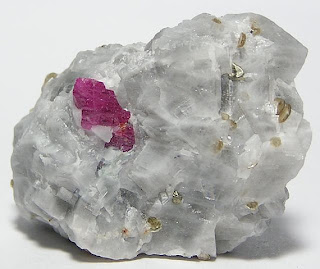The Birthstone for the month of July is the stunning Ruby!!
Along with the sapphire, emerald and diamond, the ruby is considered a
precious stone. The ruby and its sister stone the Sapphire are a member of the
corundum species...the word corundum means “very hard mineral used as an
abrasive”. You might be surprised to know the only difference between the ruby and the
sapphire is the color.
Rubies are found in Afghanistan, Australia, Cambodia, India, Kenya,
Pakistan (Kashmir), Russian, United States, (North Carolina), Greenland and
Vietnam, with some of the most important finds in Myanmar (formerly Burma),
Tanzania, Thailand, and Sri Lanka.
 |
| Deep Red Natural Ruby Crystal and Natural Faceted Ruby Cut StoneA composite terminated crystal from Madagascar and a Burmese (Myanmar) Faceted Stone, both natural |
The ruby ranges in color from pink to blood-red in color. The most desirable red (Latin – ruber) being
blood red with a touch of blue, which is called “pigeon’s blood”. The presence of chromium provides the red and
the presence of iron explains any brown tones.
The color of the ruby will vary within each deposit making it difficult
to determine the location where found by looking at the gem. When you hear
“Burma ruby” or Siam ruby” more often this is referring to the quality not the
source location of the gem.
The color is often uneven with stripes and spots throughout the gem, all
natural rubies have imperfections including impurities and inclusions such as
the needle like rutile, known as “silk” which the Gemologist uses to determine
the real ruby from the synthetic ruby. Rubies
with a 3 or 6-point star are cut into cabochons to show the star effect. The
presence of chromium provides the red and the presence of iron explains any
brown tones.
The ruby in its rough form is dull and greasy, as are most gems, but it
is said once the gem is cut “the luster can approach that of the diamond
“. Since the 1960’s it has become common for the ruby to be treated with
heat to improve the color, as a result the cost of a natural untreated Burmese
ruby of 10ct would be on par with a natural diamond! Having said that the ruby is one of the most
expensive gems, with large ones worth more than diamonds, which is why they are
often used for royalty/wealthy jewelry and insignia.
 |
| Ruby in Fuchsite (green mica) Puff Heart CabochonPuff Pillow cabochonBoth sides polishedStone mined and cut in India |
The ruby is hard with only the diamond harder, but it lacks cleavage*,
as a result the ruby is brittle therefore, cutting and setting the stone must
be done carefully.
Cleavage*: “Crystal can break along the lines of weakness related to the atomic
structure (cleavage) in such a way that a flat surface which is called a
cleavage plane is left. Where the break is not related to the fracture,
the resulting surface will not be flat or smooth. Fracture may be
described as uneven, splintery. Cleavage and fracture affect the strength
of a gemstone as well as how easy it can be worked/cut/shaped”.
I admit I was surprised to find the natural, untreated ruby is such a
valuable gem.
Some interesting information:
- The ruby is used to celebrate the 15th and 40th wedding anniversary.
- It is used in ancient times for bad health and to protect against misfortune.
- Placed on building to ensure good fortune to the building.
Don’t hesitate to contact me with any
questions or requests!
Watch for healing aspects of semi and semi
precious stones coming soon…
Cheers
- Many thanks to the photographer who so generously allowed her work to be used in my feature!
- Maryanne Fender, Fender Minerals
- Gemstones of the World, Walter Schumann,Third Addition,Sterling Publishing Co.Inc.
- The Jeweler's Directory of Gemstones, Judith Crowe, Firefly Books, 2006


Grear post, thank you for gathering all the info to one place.
ReplyDeleteI love all gemstones including Ruby. Ruby in Fuchsite is really beautiful. I have seen some over here at the local gem shop but they are really expensive and dear.
ReplyDeleteThanks for a great info in this post Heather, and looking forward to more.
Have a great week.
Informative post...you sure know your stuff. The first photo looked like a purple popsicle to me ;)
ReplyDeleteN
this was a fascinating post! I've always liked rubies, now I have even more of an appreciation for them. Cheers!
ReplyDelete